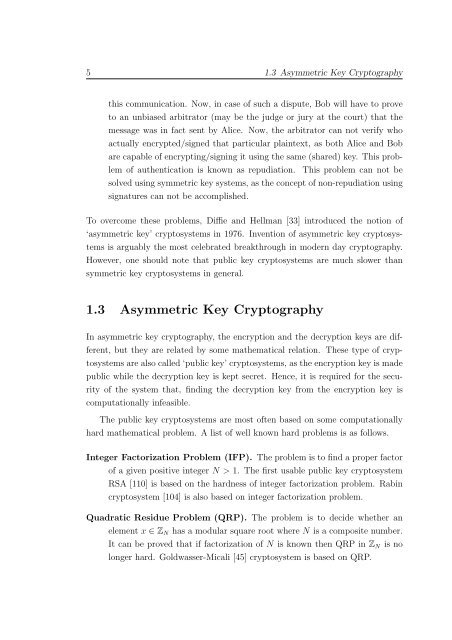Cryptanalysis of RSA Factorization - Library(ISI Kolkata) - Indian ...
Cryptanalysis of RSA Factorization - Library(ISI Kolkata) - Indian ...
Cryptanalysis of RSA Factorization - Library(ISI Kolkata) - Indian ...
Create successful ePaper yourself
Turn your PDF publications into a flip-book with our unique Google optimized e-Paper software.
5 1.3 Asymmetric Key Cryptography<br />
this communication. Now, in case <strong>of</strong> such a dispute, Bob will have to prove<br />
to an unbiased arbitrator (may be the judge or jury at the court) that the<br />
message was in fact sent by Alice. Now, the arbitrator can not verify who<br />
actually encrypted/signed that particular plaintext, as both Alice and Bob<br />
are capable <strong>of</strong> encrypting/signing it using the same (shared) key. This problem<br />
<strong>of</strong> authentication is known as repudiation. This problem can not be<br />
solved using symmetric key systems, as the concept <strong>of</strong> non-repudiation using<br />
signatures can not be accomplished.<br />
To overcome these problems, Diffie and Hellman [33] introduced the notion <strong>of</strong><br />
‘asymmetric key’ cryptosystems in 1976. Invention <strong>of</strong> asymmetric key cryptosystems<br />
is arguably the most celebrated breakthrough in modern day cryptography.<br />
However, one should note that public key cryptosystems are much slower than<br />
symmetric key cryptosystems in general.<br />
1.3 Asymmetric Key Cryptography<br />
In asymmetric key cryptography, the encryption and the decryption keys are different,<br />
but they are related by some mathematical relation. These type <strong>of</strong> cryptosystems<br />
are also called ‘public key’ cryptosystems, as the encryption key is made<br />
public while the decryption key is kept secret. Hence, it is required for the security<br />
<strong>of</strong> the system that, finding the decryption key from the encryption key is<br />
computationally infeasible.<br />
The public key cryptosystems are most <strong>of</strong>ten based on some computationally<br />
hard mathematical problem. A list <strong>of</strong> well known hard problems is as follows.<br />
Integer <strong>Factorization</strong> Problem (IFP). The problem is to find a proper factor<br />
<strong>of</strong> a given positive integer N > 1. The first usable public key cryptosystem<br />
<strong>RSA</strong> [110] is based on the hardness <strong>of</strong> integer factorization problem. Rabin<br />
cryptosystem [104] is also based on integer factorization problem.<br />
Quadratic Residue Problem (QRP). The problem is to decide whether an<br />
element x ∈ Z N has a modular square root where N is a composite number.<br />
It can be proved that if factorization <strong>of</strong> N is known then QRP in Z N is no<br />
longer hard. Goldwasser-Micali [45] cryptosystem is based on QRP.
















